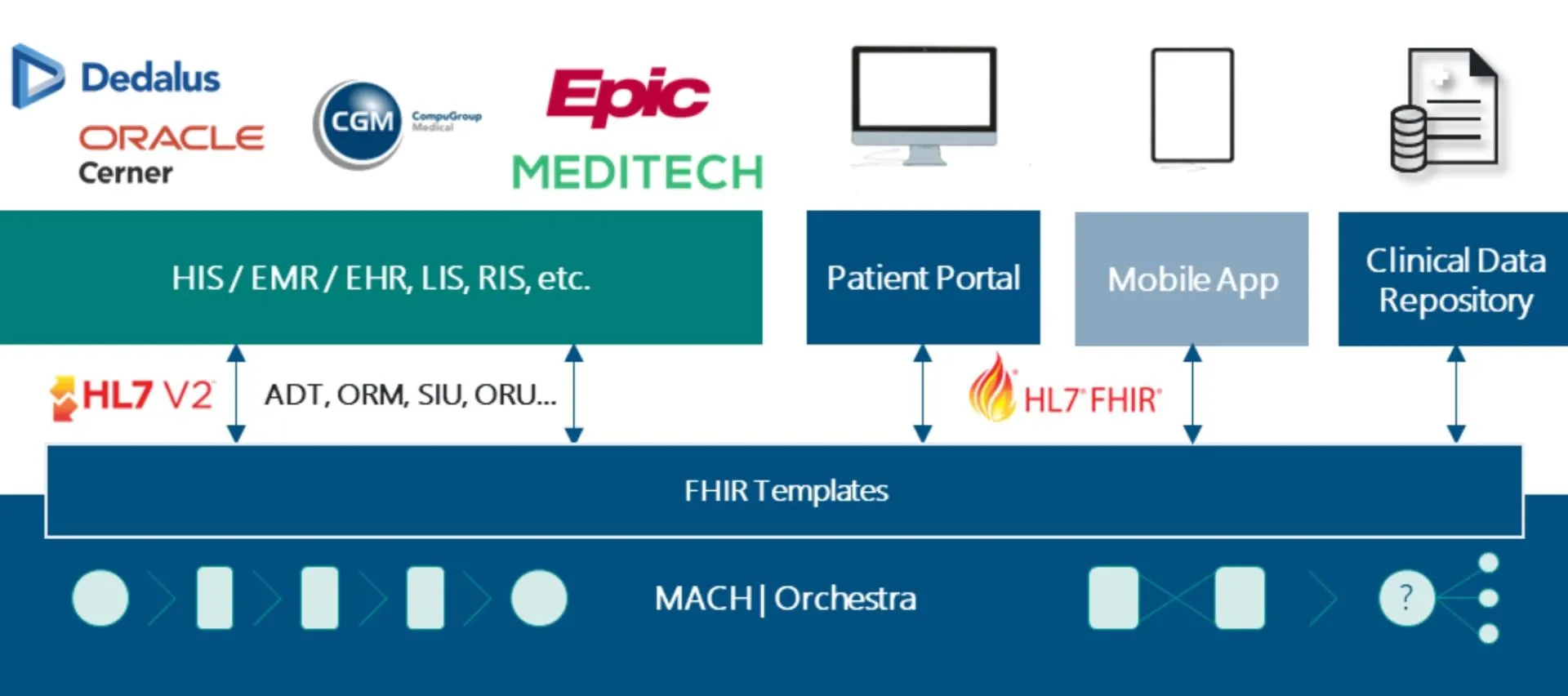The MACH | Orchestra HL7 FHIR Templates (or FHIR Templates for short) are an always-growing implementation of several Orchestra scenarios that enable healthcare organizations to leverage the FHIR standard and create an integrated clinical landscape without artificial barriers, and without depending on individual vendors to enhance their solutions, thus protecting your existing investments.
FHIR Templates

HL7, FHIR and the ![]() Logo are registered trademarks belonging to Health Level Seven International.
Logo are registered trademarks belonging to Health Level Seven International.
The FHIR Templates comprise several modules:
The Interaction Module handles the complete communication with external systems. It performs the following tasks:
- Receiving the HL7 messages via MLLP
- Optional invocation of an Orchestra service to customize HL7 messages so that they are compatible for FHIR mappings (important especially for identifiers of individual resources).
- Forwarding of the HL7 message to the individual subject modules
- Receipt of the FHIR resources from the individual functional modules
The Administration Module creates FHIR resources from HL7 v2.x ADT (Admit, Discharge and Transfer) messages and currently includes the following features:
- Support for the following ADT events: A01 – A16, A21 – A29, A31 – A33, A37, A38, A40, A42, A47, A50, A52 – A55, A60 – A62
- Support for the following FHIR resources: Patient, Encounter, Practitioner, Location, Device, Condition, Observation, AllergyIntolerance
- Configuration of the FHIR resources to be created at the level of individual ADT events
- Configuration of the HL7 fields to be used for the Practitioner FHIR resource
- Configuration of the HL7 fields to be used for the Location FHIR resource
The Order Module creates FHIR resources from HL7 v2.x ORM (Order Entry) messages and includes the following features:
- Support for the following ORM event: O01
- Support for the following FHIR resources: Patient, Encounter, Practitioner, Location, Device, ServiceRequest, Condition, Observation
- Configuration of the FHIR resources to be created
- Configuration of the HL7 fields to be used for the Practitioner FHIR resource
- Configuration of the HL7 fields to be used for the Location FHIR resource
The Appointment Module creates FHIR resources from HL7 v.2x SIU (Scheduling Information – Unsolicited) messages and includes the following features:
- Support for the following SIU events: S12 – S22
- Support for the following FHIR resources: Patient, Encounter, Practitioner, Location, Condition, Observation, Appointment
- Configuration of the FHIR resources to be created at the level of individual SIU events
- Configuration of the HL7 fields to be used for the Practitioner FHIR resource
- Configuration of the HL7 fields for the Location FHIR resource
The Observation Module creates FHIR resources from HL7 v2.x ORU (Observation Result) messages and includes the following features:
- Support for the following ORU events: R01, R30
- Support for the following FHIR resources: Patient, Encounter, Practitioner, Location, Device, ServiceRequest, Observation
- Configuration of the FHIR resources to be created at the level of individual ORU events
- Configuration of the HL7 fields to be used for the Practitioner FHIR resource
- Configuration of the HL7 fields to be used for the Location FHIR resource
MACH | Orchestra
Healthcare Integration Engine
Whether you’re synchronizing patient data or transferring clinical results electronically, it’s all about connecting patient data, documents and hospitals.